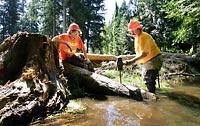Group takes long view in North Creek cleanup

The Adopt-A-Stream Foundation is embarking on a long-term effort to repair damage to North Creek that urban development has caused over the years.
By completing one piece at a time with the help of a $407,000 grant from the state Department of Ecology, the nonprofit says it can reach its goal.
But the key component is willing landowners, because most of North Creek and its tributaries run through private property.
Off 183rd Street Southeast north of Bothell, a North Creek project designed to reduce thermal pollution will enhance the habitat for juvenile salmon. The foundation is replacing vegetation and removing invasive plant species where Penny Creek, a tributary of North Creek, runs through Mill Creek Country Club. At 228th Street Southeast, an undersize culvert will be replaced, allowing freer movement of salmon.
This is just the beginning. Tom Murdoch, the foundation's executive director, said he has identified about a dozen projects along the creek where it flows through McCollum Park. (The foundation has its headquarters in the park.)
North Creek flows for almost 13 miles through Snohomish and King counties before emptying into the Sammamish River near Lake Washington, meaning there could be more than 100 restoration projects, Murdoch said. Snohomish County and cities through which North Creek flows already are doing restorative work on public land.
"We're walking the stream system by invitation," Murdoch said. "We're trying to get the word out to stream-side landowners along North Creek and its tributaries."
For landowners, it means little more than allowing access to the stream and believing in the work. Bonnie Smith, who lives off 183rd, said reality has equaled the vision.
"I've lived here more than 20 years and seen the salmon come and go," she said. "So this was something my late husband and I had already talked about."
Smith hopes the finished project in her back yard will spur other landowners to participate.
"This group is not destroying the land as far as I'm concerned," she said. "It's an enhancement."
In Smith's back yard, foundation members have been busy anchoring large root wads and logs. Once they're in place, the straight-flowing stream will have no choice but to migrate, scouring out sand underneath the logs and creating deeper, cooler pools of water where young salmon can hide.
Replanting the streambed will create shade and decrease water temperatures, considered a pollution factor that can hinder salmon development.
Though Smith has been an advocate, foundation member John Ucciferri said the project initially had been designed for a site farther downstream until the landowner dropped out.
"All these projects are contingent on willing landowners," Ucciferri said.
The foundation plans to keep surveying the streams and identifying pollution or degradation problems it can fix. Money will continue to come from the Department of Ecology grant and other sources, Murdoch said.
"There's no cost to the landowner unless they want to do more than we have the means to do," he said.
Christopher Schwarzen: 425-783-0577 or cschwarzen@seattletimes.com